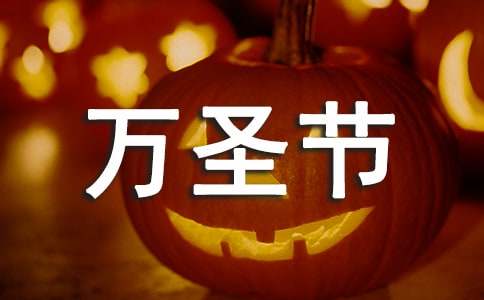- 相關推薦
萬圣節(jié)的起源英文版
一年中最”鬧鬼“的這天夜里,各種妖魔鬼怪、 海盜、 外星來客和巫婆們紛紛出動。在這個萬圣節(jié),小編給大家準備了萬圣節(jié)的起源英語介紹,一起來看一下吧!

Halloween (or Halloween) is an annual holiday observed on October 31, which commonly includes activities such as trick-or-treating, attending costume parties, carving jack-o-lanterns, bonfires, apple bobbing, visiting haunted attractions, playing pranks, telling scary stories, and watching horror films arevery happy.
Halloween (or Halloween) is an annual holiday observed on October 31, which commonly includes activities such as trick-or-treating, attending costume parties, carving jack-o-lanterns, bonfires, apple bobbing, visiting haunted attractions, playing pranks, telling scary stories, and watching horror films.
History
Historian Nicholas Rogers, exploring the origins of Halloween, notes that while "some folklorists have detected its origins in the Roman feast of Pomona, the goddess of fruits and seeds, or in the festival of the dead called Parentalia, it is more typically linked to the Celtic festival of Samhain, whose original spelling was Samuin (pronounced sow-an or sow-in)".
The name is derived from Old Irish and means roughly "summers end".Snap-Apple Night (1832) by Daniel Maclise.Depicts apple bobbing and divination games at a Halloween party in Blarney, Ireland.The name Halloween and many of its present-day traditions derive from the Old English era.
The word Halloween is first attested in the 16th century and represents a Scottish variant of the fuller All-Hallows-Even ("evening"), that is, the night before All Hallows Day.[4] Although the phrase All Hallows is found in Old English (ealra hālgena mssedg, mass-day of all saints), All-Hallows-Even is itself not attested until 1556.
11月1日 -- 萬圣節(jié) All Saints Day
11月2日 -- 墨西哥的鬼節(jié) Day of Death
萬圣節(jié)(All Saints Day, All Hallows Day或Hallowmas) 是每年11月1日 的歐美大節(jié)日。
Halloween 是 All Hallows Eve 的縮寫,萬圣節(jié)前夜的意思,指10月31日的晚上。
For thousands of years people have been celebrating different holidays and festivals at the end of October. The Celts celebrated it as Samhain (pronounced “sow-in”, with “sow” rhyming with cow). The Irish English dictionary published by the Irish Texts Society defines the word as follows:
“Samhain, All Hallowtide, the feast of the dead in Pagan and Christian times, signalizing the close of harvest and the initiation of the winter season, lasting till May, during which troops (esp. the Fiann) were quartered. Faeries were imagined as particularly active at this season. From it the half year is reckoned. also called Feile Moingfinne (Snow Goddess).
(1) The Scottish Gaelis Dictionary defines it as ”Hallowtide. The Feast of All Soula. Sam + Fuin = end of summer.“(2) Contrary to the information published by many organizations, there is no archaeological or literary evidence to indicate that Samhain was a deity. The Celtic Gods of the dead were Gwynn ap Nudd for the British, and Arawn for the Welsh. The Irish did not have a ”lord of death“ as such.
The Celts believed that every year on the last day of October, the souls of the dead visited the earth.www.
When the Romans conquered the Celts in the first century A.D., they added parts of their festivals, Feralia and Pomona to the tradition. Feralia was a festival to honor the dead and Pomona was a harvest festival named after the goddess of fruit (apples) and trees.
Around the eigth century, the Christian church made November 1 All Saints Day to honor all of the saints that didnt have a special day of their own. Over the years these festivals combined, the mass held on All Saints Day was called Allhallowmas (the mass of all Hallows - saintly people). The night before was known as All Hallows Eve. Eventually this name became Halloween.
In the 1800s, as a lot of people emigrated to the U.S., the holidays and traditions of different cultures merged. Halloween was not always a happy time. October 31, or the night before took on other names. Some called it Devils or Hell night, to others it was mischief night. Here in Vermont, the night before is called cabbage night.
To some people this became a time to play tricks on others. Some of these tricks were not fun at all. Luckily, community groups and individuals took action and started to change Halloween into a family event. Dressing up in costumes and going ”trick or treating“, costume parades, community parties and Fall festivals are some of the ways that Halloween is celebrated today.
Other countries have different Fall festivals to honor the deceased.
The Festival of the Dead is one of the most important happenings in both Palermo and the rest of Sicily. The second of November is a festival day for the children of Palermo as, according to tradition,they were made to believe that their dead relatives would return the night before and leave them traditional sweets and cakes on the table (Martorana fruit, which is almond paste made into the shape of different fruit). They would also receive puppets of boiled sugar and toys. Its one way of keeping the memory of their dead relatives and loved ones alive.
萬圣節(jié)小學英語作文之萬圣節(jié)的起源
While there are many versions of the origins and old customs of Halloween, some remain consistentby all accounts. Different cultures view Halloween somewhat differently but traditional Halloween practices remain the same.
盡管關于萬圣節(jié)的起源和舊俗有很多不同的看法,但有一些是被所有人接受的。不同文化看待萬圣節(jié)總是有點不同,但是傳統(tǒng)的萬圣節(jié)做的事情都是一樣的。
Halloween culture can be traced back to the Druids, a Celtic culture in Ireland, Britain and Northern Europe. Roots lay in the feastof Samhain, which was annually on October 31st to honor the dead.
萬圣節(jié)文化可以追溯到德魯伊教,這是一種愛爾蘭、北歐和英國的凱爾特文化,根植于Samhain節(jié)的慶祝活動,Samhain節(jié)于每年的10月31日紀念逝者。
Samhain signifies "summers end" or November. Samhain was a harvest festival with huge sacred bonfires, marking the end of the Celtic year and beginning of a new one. Many of the practices involved in this celebration were fed on superstition.
Samhain節(jié)說明夏天結束或者十一月,是一個豐收的節(jié)日。在Samhain節(jié)會燃起神圣巨大的篝火,標志著凱爾特一年的結束和新一年的開始。一些做法因為迷信被加入慶祝活動中。
The Celts believed the souls of the dead roamed the streets and villages at night. Since not all spirits were thought to be friendly, gifts and treats were left out to pacifythe evil and ensure next years crops would be plentiful. This custom evolved into trick-or-treating.
凱爾特人相信死者的靈魂會在夜里出沒在街道和村莊 。因為他們認為不是所有的靈魂都是友善的,所以就把禮物和好吃的留在外面安慰惡靈來確保來年的莊稼可以豐收。這種習俗演變成了trick-or-treating.
【萬圣節(jié)的起源英文版】相關文章:
萬圣節(jié)的介紹英文版11-02
象棋的起源08-10
拓展訓練的起源06-01
舞蹈的起源與發(fā)展09-22
瑜伽的起源與功效08-11
古箏起源介紹08-24
昆曲的起源與發(fā)展03-26
擊劍運動的歷史起源10-18